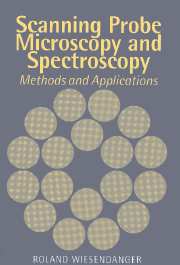Book contents
- Frontmatter
- Contents
- Preface
- List of acronyms
- Introduction
- Part one Experimental methods and theoretical background of scanning probe microscopy and spectroscopy
- Part two Applications of scanning probe microscopy and spectroscopy
- 4 Condensed matter physics
- 5 Chemistry
- 6 Organic material
- 7 Metrology and standards
- 8 Nanotechnology
- References
- Index
4 - Condensed matter physics
Published online by Cambridge University Press: 05 October 2010
- Frontmatter
- Contents
- Preface
- List of acronyms
- Introduction
- Part one Experimental methods and theoretical background of scanning probe microscopy and spectroscopy
- Part two Applications of scanning probe microscopy and spectroscopy
- 4 Condensed matter physics
- 5 Chemistry
- 6 Organic material
- 7 Metrology and standards
- 8 Nanotechnology
- References
- Index
Summary
Condensed matter physics deals with systems containing a large number of atoms (typically 1023 cm−3) that form a dense aggregate. Theoretical treatment of such complex systems has traditionally been based on simplifying concepts.
The concept of totally neglecting the microscopic structure is used in phenomenological theories for macroscopic systems, such as thermodynamical or continuum mechanical descriptions.
The concept of a statistical theoretical treatment of a large number of atoms appears as a link between a macroscopic and microscopic description, where macroscopic observables are attributed to the average properties of the constituents of the whole aggregate, whereas fluctuations resulting from the individual behavior of single atoms are assumed to be negligible.
The concept of idealizing the microscopic structure of macroscopic systems has led to the foundation of modern condensed matter theory. Most notably, the concept of the perfect crystal, whose atoms are arranged in space with strict periodic order, has been used as a starting point for a profound description of real crystalline solids. The strict periodicity present in a perfect crystal allows rigorous theoretical treatment, leading to exact solutions of the Schrödinger equation. However, these solutions emphasize the collective properties of the many atoms chemically bound in the crystal, whereas the individuality of each atom is again lost.
The experimental techniques traditionally applied to investigation of the condensed state of matter, such as diffraction, specific heat, electrical transport or magnetization measurements, have also focused on average and collective properties of the many atoms in a macroscopic system.
- Type
- Chapter
- Information
- Scanning Probe Microscopy and SpectroscopyMethods and Applications, pp. 291 - 467Publisher: Cambridge University PressPrint publication year: 1994
- 2
- Cited by

